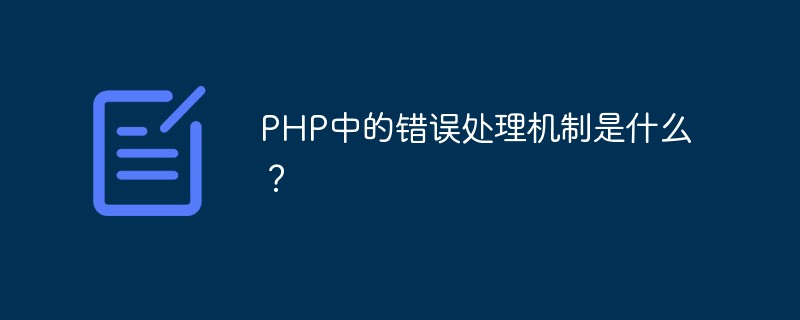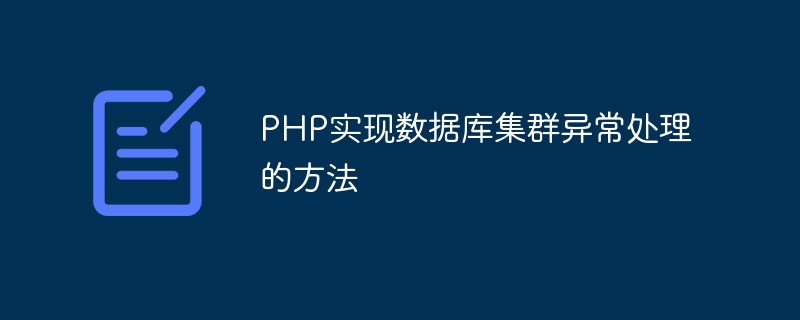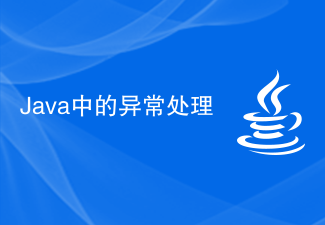
How to handle exceptions and error recovery in PHP development requires specific code examples
In the PHP development process, handling exceptions and error recovery is very important. Reasonable exception handling and error recovery mechanisms can improve the robustness and maintainability of the code, and can better display error information to users and improve user experience. This article will introduce several common methods of handling exceptions and errors in PHP and provide specific code examples.
- Use try-catch block to handle exceptions
In PHP, you can use try-catch block to catch and handle exceptions. When an exception occurs in the code block, it will jump to the catch block to execute the corresponding processing logic. The following is a sample code:
try {
// 可能会触发异常的代码
$result = 10 / 0;
} catch (Exception $e) {
// 处理异常的代码
echo "发生异常:" . $e->getMessage();
// 其他处理逻辑
}In the above code, we deliberately trigger an exception by dividing by 0, and then use the catch block to catch the exception and output the exception information.
- Use custom exception classes
In addition to using the built-in Exception class to catch exceptions, we can also customize exception classes to achieve more flexibility exception handling. By creating a custom exception class, different types of exceptions can be captured separately and handled differently according to specific situations. The following is a sample code:
class CustomException extends Exception {
public function __construct($message, $code = 0, Exception $previous = null) {
parent::__construct($message, $code, $previous);
}
public function __toString() {
return __CLASS__ . ": [{$this->code}]: {$this->message}
";
}
// 其他自定义异常处理方法
}
try {
// 可能会触发异常的代码
if ($file = fopen("nonexistent.txt", "r")) {
echo "文件打开成功。";
}
} catch (CustomException $e) {
// 处理自定义异常的代码
echo "发生自定义异常:" . $e->getMessage();
// 其他处理逻辑
} catch (Exception $e) {
// 处理其他异常的代码
echo "发生异常:" . $e->getMessage();
// 其他处理逻辑
} In the above code, we have customized a CustomException class that inherits from the Exception class, and then passes catchBlocks capture CustomException and other types of exceptions respectively, and handle them accordingly.
- Using error handling functions
In addition to exception handling, PHP also provides some error handling functions for catching and handling errors. The following are some commonly used error handling functions:
-
set_error_handler(): Set a custom error handling function. -
error_reporting(): Set the error level reported by PHP. -
trigger_error(): Artificially trigger an error. -
error_log(): Write error information to the log file.
The following is a sample code that uses an error handling function to handle errors:
function customErrorHandler($errno, $errstr, $errfile, $errline) {
echo "发生错误:{$errstr},位于文件 {$errfile} 的第 {$errline} 行。<br>";
}
set_error_handler("customErrorHandler");
// 触发一个错误
trigger_error("这是一个自定义的错误。", E_USER_ERROR);In the above code, we set an automatic function through the set_error_handler() function. Define the error handling function customErrorHandler(), and then manually trigger an error through the trigger_error() function.
By combining exception handling and error handling, we can better handle exceptions and errors and ensure the robustness and maintainability of the code. Of course, in actual development, exception handling and error handling methods should be reasonably selected according to actual needs, and corresponding optimization and improvements should be made.
The above is the detailed content of How to handle exceptions and error recovery in PHP development. For more information, please follow other related articles on the PHP Chinese website!
 PHP中API如何处理异常处理和重试机制Jun 17, 2023 pm 03:52 PM
PHP中API如何处理异常处理和重试机制Jun 17, 2023 pm 03:52 PMPHP中API如何处理异常处理和重试机制在PHP中,API已经成为许多网站和应用程序的核心,因为它们提供各种功能和功能。然而,在使用API时,我们经常会遇到许多问题,如网络连接问题,响应超时,无效请求等。在这种情况下,我们需要了解如何处理异常和重试机制来确保我们的应用程序的可靠性和稳定性。异常处理在PHP中,异常处理是一种更加优雅和可读的错误处
 Go语言框架开发中的异常处理与错误码设计Jun 05, 2023 pm 09:21 PM
Go语言框架开发中的异常处理与错误码设计Jun 05, 2023 pm 09:21 PM随着互联网技术的不断发展,越来越多的企业开始使用Go语言进行开发。Go语言以其高效、稳定、易用的特点备受开发者的青睐。在企业级开发中,框架是不可或缺的一部分。因此,本文将介绍在Go语言框架开发中,如何进行异常处理与错误码设计。一、什么是异常处理在计算机编程中,异常处理指的是当程序运行过程中出现异常情况时,程序必须采取的措施。这些异常情况包括硬件故障、软件缺陷
 PHP中的错误处理机制是什么?May 12, 2023 pm 07:31 PM
PHP中的错误处理机制是什么?May 12, 2023 pm 07:31 PMPHP是一种流行而强大的服务器端编程语言,可以用来开发各种Web应用程序。就像其他编程语言一样,PHP也有可能会出现错误和异常。这些错误和异常可能由各种原因引起,如程序错误、服务器错误、用户输入错误等等。为了确保程序的运行稳定性和可靠性,PHP提供了一套完整的错误处理机制。PHP错误处理机制的基本思想是:当发生错误时,程序会停止执行并输出一条错误消息。我们可
 Swoole实现高效的异常处理机制Jun 14, 2023 pm 03:54 PM
Swoole实现高效的异常处理机制Jun 14, 2023 pm 03:54 PM随着Web开发技术的不断发展,开发人员也面临着越来越复杂的业务场景和需求。例如,高并发、大量请求处理、异步任务处理等问题都需要使用高性能的工具和技术来解决。在这种情况下,Swoole成为了一种越来越重要的解决方案。Swoole是一种基于PHP语言的高性能异步网络通信框架。它提供了一些非常有用的功能和特性,例如异步IO、协程、进程管理、定时器和异步客户端,使得
 如何在ThinkPHP6中进行异常处理?Jun 12, 2023 am 08:54 AM
如何在ThinkPHP6中进行异常处理?Jun 12, 2023 am 08:54 AMThinkPHP6是一款非常流行的PHP框架,已经被广泛应用于各种Web应用程序中。在开发过程中,可能会遇到各种异常,如果不及时处理,就会导致程序无法正常运行。本文将介绍如何在ThinkPHP6中进行异常处理,保证Web应用程序的稳定性和可靠性。异常处理的概念异常处理是指在程序正常执行过程中,遇到错误或意外情况时所进行的处理。在开发Web应用程序时,常常会发
 PHP实现数据库集群异常处理的方法May 15, 2023 pm 02:40 PM
PHP实现数据库集群异常处理的方法May 15, 2023 pm 02:40 PM随着互联网的不断发展,越来越多的企业和组织开始规划数据库集群来满足其数据处理需求。数据库集群可能包含数百甚至数千个节点,因此在节点之间确保数据同步和协调非常重要。在该环境下,存在着很多的异常情况,如单节点故障,网络分区,数据同步错误等,并且需要实现实时检测和处理。本文将介绍如何使用PHP实现数据库集群异常处理。数据库集群的概述在数据库集群中,一个单独的
 Java中的异常处理Jun 15, 2023 pm 11:16 PM
Java中的异常处理Jun 15, 2023 pm 11:16 PMJava是一种面向对象的程序设计语言,由于其很高的稳定性和安全性,成为了一种广泛应用的编程语言。然而,在程序开发过程中,异常总是不可避免的问题。由于Java语言天生具有处理异常的功能,因此它可以通过异常处理机制来避免程序崩溃,保证程序的正常运行。一、Java中的异常概述在Java中,异常是指程序发生了不正常的情况,如数组越界、除数为零、文件未找到等等。但是这
 Yii框架中的错误页面与异常处理Jun 21, 2023 pm 03:27 PM
Yii框架中的错误页面与异常处理Jun 21, 2023 pm 03:27 PMYii框架是一款广泛应用于Web应用程序开发的高性能PHP框架。在Yii的应用程序中,错误页面和异常处理模块是非常重要的功能之一。本文将简要介绍Yii框架中的错误页面和异常处理模块,并提供一些实用的示例代码,以帮助您更好地理解和使用这些功能。一、错误页面当用户访问一个不存在的页面、发生了错误的连接或者其他错误时,Yii框架会默认显示一个错误页面。这个页面通常


Hot AI Tools

Undresser.AI Undress
AI-powered app for creating realistic nude photos

AI Clothes Remover
Online AI tool for removing clothes from photos.

Undress AI Tool
Undress images for free

Clothoff.io
AI clothes remover

AI Hentai Generator
Generate AI Hentai for free.

Hot Article

Hot Tools

SublimeText3 Chinese version
Chinese version, very easy to use

mPDF
mPDF is a PHP library that can generate PDF files from UTF-8 encoded HTML. The original author, Ian Back, wrote mPDF to output PDF files "on the fly" from his website and handle different languages. It is slower than original scripts like HTML2FPDF and produces larger files when using Unicode fonts, but supports CSS styles etc. and has a lot of enhancements. Supports almost all languages, including RTL (Arabic and Hebrew) and CJK (Chinese, Japanese and Korean). Supports nested block-level elements (such as P, DIV),

ZendStudio 13.5.1 Mac
Powerful PHP integrated development environment

Atom editor mac version download
The most popular open source editor

EditPlus Chinese cracked version
Small size, syntax highlighting, does not support code prompt function






